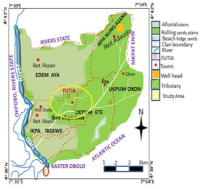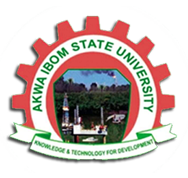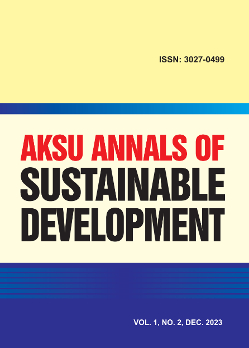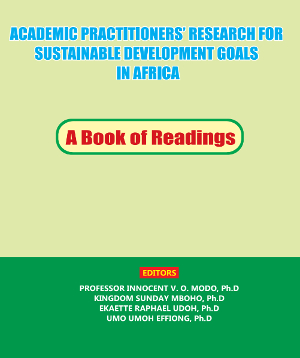GEOELECTRIC INVESTIGATION OF THE GROUNDWATER POTENTIAL IN FEDERAL UNIVERSITY OF TECHNOLOGY AREA, IKOT ABASI, AKWA IBOM STATE, NIGERIA
DOI:
https://doi.org/10.60787/AASD-v1i2-24Keywords:
Groundwater, geoelectric measurement, aquifer, layers, thicknessAbstract
Geoelectric measurements using the Vertical Electrical Sounding (VES) method were carried out in Federal University of Technology Area, Ikot Abasi, Akwa Ibom State, Nigeria, using the Integrated Geo Instruments and services resistivity meter (IGIS) Terrameter (SAS 1000). The objectives of the study were to investigate the aquifer characteristics and groundwater potential of the subsurface formations. Ten (10) profiles were carried out using the Schlumberger array configuration for the mapping of the prospect, with maximum current electrode separation of 200m. The data was interpreted using the conventional curve matching and computer iteration methods. The data was interpreted using the WinRESIST and computer iteration methods to obtain the resistivity, thickness and depth of the subsurface. Results show that four major curve types were identified, namely: A, H, K and Q depending on the resistivity distribution with depth. The area was observed to have 3 to 4 geoelectric layers. The third layer for VES 1 and VES 2 has a thickness of 71.8m and 66.5m; while, VES 3, VES 5 and VES 7 at the second layer have 56.3m, 66.3m and 51.1m respectively. Generally, the study area has a thickness range of 50m to 80m. The lowest value of the bulk resistivity is 18.1 and the highest value is 1412.3, for VES 10 and VES 4 respectively. VES stations 1,2,3,5,7,8,9 and10 are the locations that will be recommended for deep well sitting, because they have highest thickness of both weathered zone and fractured zone respectively which are good for groundwater storage.
Downloads
References
Aluminum Smelter Company of Nigeria (ALSCON). (1997): Ikot Abasi - The Aluminum Town: Socio-Economic Transformation of a Nigeria Community.
Attai, E., Ebong, S., Thaddeus, S., and Joshua, E. (2015): Application of Vertical Electrical Sounding to Investigate the Groundwater Potential in Abak Local Government Area, Akwa Ibom State, Nigeria. Journal of Geography, Environment and Earth Science International 3(1): 1-12, Article no.JGEESI.17832 SCIENCEDOMAIN international, www.sciencedomain.org
Coker JO, Makinde V, Olowofela JA (2009). Geophysical Investigation of Groundwater Potentials of Oke-Badan Estate, Ibadan, Southwestern, Nigeria. Proceedings of 3rd International Conference on Science and National Development University of Agric. Abeokuta, p. 119.
Dan-Hassan MA, Olorunfemi MO (1999). Hydro-geophysical investigation of a basement terrain in the north central part of the Kaduna state, Nigeria. J. Min. Geol., 35(2): 189-206.
Ebong, S., and Akpabio, G. (2013): Comparative Study of Electricity and Thermal Conductivity of Three Land Form in Akwa Ibom State. International Journal of Advance Research, Ijoar. Org. Volume 1, Issue 8, Online: ISSN 2320-9186 Pp. 1- 14.
Ebong, S., Ekanem, M., and George, N. (2023): Reservoir Characterisation Using Seismic Inversion Techniques for Mapping of Prospects. Researchers Journal of Science and Technology (REJOST) (2023), 3(1): 1 - 13 https://rejost.com.ng
Ebong, S., Attai, E., and Joshua, E. (2016): Measurement of Thermal Conductivity and Specific Heat Capacity of Three Major Geo-morphological Units in Akwa Ibom State, Nigeria. British Journal of Applied Science & Technology, 12(2): 1-7, 2016, Article no.BJAST.17834 ISSN: 2231-0843, NLM ID: 101664541 SCIENCEDOMAIN international, www.sciencedomain.org
Ebong, S., Akpabio, G., and Atai, E. (2013): Comparative Study of Thermal Conductivity and Density of Three Land Forms in Akwa Ibom State. International Journal of Physics and Applications, © International Research Publication House. http://www.irphouse.comISSN 0974-3103 Volume 5, Number 2, pp. 83-89.
Ebong, S., Akpabio, G., Atai, E., Oji, H., and Umoren, E. (2014): Thermal Properties of Three Major Landforms in Akwa Ibom State, Nigeria. International Research Journal of Pure Applied Physics, Vol. 2, No.2, Pp. 10-19, June 2014 Published by European Centre for Research Training and Development UK (www.ea-journals.org).
Joshua, E., Odeyemi, O., and Fawehinmi, O. (2011): Geo-electric investigation of the groundwater potential of Moniya Area, Ibadan. Journal of Geology and Mining Research Vol. 3(3), pp. 54-62, March 2011. Available online http://www.academicjournals.org/jgmr
Ojo JS, Ayangbesan TA, Olorunfemi MO (1990). Geo-physical Survey of Dam Site: A Case Study. J. Min. Geol., 26(2): 201-206.
Olayinka AI (1990). Case histories of multi-electrode resistivity profiling array for groundwater in basement complex areas of Kwara state, Nigeria. J. Min. Geol., 26(1): 27-34.
Omosuyi GO, Ojo JS, Olorunfemi MO (2008). Geo-electric Sounding to Delineate Shallow Aquifer in the Coastal Plain Sands of Okitipupa Area, Southwestern Nigeria. Pacific J. Sci. Technol., 9(2): 562-577.
World Health Organization(WHO) (1996). Guidelines for Drinking Water, Vol. 1, Recommendation. Geneva Switzer

Downloads
Published
Issue
Section
License
Copyright (c) 2024 AKSU Annals of Sustainable Development

This work is licensed under a Creative Commons Attribution-NonCommercial-NoDerivatives 4.0 International License.
Manuscript content on this site is licensed under Creative Commons Licenses. Authors wishing to include figures, tables, or text passages that have already been published elsewhere are required to obtain permission from the copyright owner(s) for both the print and online format and to include evidence that such permission has been granted when submitting their papers. Any material received without such evidence will be assumed to originate from the authors.





 ICIDR Publishing House
ICIDR Publishing House